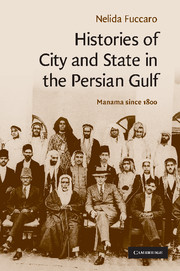Book contents
- Frontmatter
- Contents
- List of illustrations
- List of maps
- Acknowledgements
- Note on transliteration and terminology
- Glossary
- List of abbreviations
- Map 1 The Persian Gulf and Bahrain in the regional context
- Map 2 Bahrain's settlements
- CAMBRIDGE MIDDLE EAST STUDIES 30
- Introduction
- 1 Indigenous state traditions and the dialectics of urbanisation in Bahrain, 1602–1923
- 2 The making of Gulf port towns before oil
- 3 Ordering space, politics and community in Manama, 1880s–1919
- 4 Restructuring city and state: the municipality and local government
- 5 ‘Disorder’, political sociability and the evolution of the urban public sphere
- 6 City and countryside in modern Bahrain
- Conclusion
- Bibliography
- Index of persons, tribes and families
- Index of subjects
- Index of places
3 - Ordering space, politics and community in Manama, 1880s–1919
Published online by Cambridge University Press: 20 January 2010
- Frontmatter
- Contents
- List of illustrations
- List of maps
- Acknowledgements
- Note on transliteration and terminology
- Glossary
- List of abbreviations
- Map 1 The Persian Gulf and Bahrain in the regional context
- Map 2 Bahrain's settlements
- CAMBRIDGE MIDDLE EAST STUDIES 30
- Introduction
- 1 Indigenous state traditions and the dialectics of urbanisation in Bahrain, 1602–1923
- 2 The making of Gulf port towns before oil
- 3 Ordering space, politics and community in Manama, 1880s–1919
- 4 Restructuring city and state: the municipality and local government
- 5 ‘Disorder’, political sociability and the evolution of the urban public sphere
- 6 City and countryside in modern Bahrain
- Conclusion
- Bibliography
- Index of persons, tribes and families
- Index of subjects
- Index of places
Summary
Between the accession to power of Shaykh ‘Isa ibn ‘Ali Al Khalifah in 1869 and the establishment of municipal government in 1919, the growth of Manama reflected the evolution of Bahrain's pearling and entrepôt economies and the increasing importance of the Government of India in fostering its semi-autonomous position within the Al Khalifah domains. At the turn of the twentieth century, the urban layout revealed the relative weakness of the tribal administration and the critical role played by trade and immigration in the expansion of the previous decades. Unlike Muharraq, which developed around the residences of the Al Khalifah family, Manama did not have a clearly defined administrative and political centre. Its configuration was to a great extent the result of the spatial and demographic requirements of the maritime economy which dominated urban life. The successive waves of rural and overseas immigrants and the increasing volume of trade were matched by the development of the harbour and the markets, fostering the growth of residential districts along the seafront.
While the town developed gradually throughout the nineteenth century, its political and social orders crystallised in the years of the pearl boom, particularly after the 1880s. In this period the accelerated development of the harbour, markets, neighbourhoods and religious institutions unveils the ‘dynamics of power’ which characterised the rise of a powerful merchant class and the contest, as well as the symbiotic relationship, between merchants and rulers on the one hand and the Al Khalifah and British agents on the other.
- Type
- Chapter
- Information
- Histories of City and State in the Persian GulfManama since 1800, pp. 73 - 111Publisher: Cambridge University PressPrint publication year: 2009

